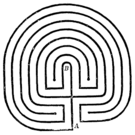 I have often confused the word labyrinth and maze, thinking that they were one and the same thing. The labyrinth pictured above is at Willen Lake, Milton Keynes, where I once lived.
I have often confused the word labyrinth and maze, thinking that they were one and the same thing. The labyrinth pictured above is at Willen Lake, Milton Keynes, where I once lived.I saw it, but did not think much of it. I thought it was silly- there's no hedges or anything, you can't get lost, what's the point in that?!
I did not know what the labyrinth was.
There is actually a vast difference between a maze and a labyrinth. A maze confuses, distresses, excites, and terrifies, whereas a labyrinth calms, heals, comforts and balances.
The labyrinth is an ancient tool of meditation, a symbol of spiritual journey. It was used in medieval cathedrals, such as Our Lady of Chartres in France. It was thought of as a symbolic form of pilgrimage, for people who could not afford to travel to holy sites.
In the States, labyrinths are being used in hospitals as a complementary therapy for inner healing.
Homer's Iliad records that Ariadne of Crete had a labyrinth dancing ground. The classical seven circuit labyrinth, sometimes called the 'Cretan labyrinth' is shown below.
 Crete means 'stong, or ruling, goddess.' In this ancient civillization, the achievements in government and peaceful arts were more advanced than any other Mediterranean society. Women were powerful leaders in religion and society. And they worshipped a Goddess, whom many identify as Ariadne.
Crete means 'stong, or ruling, goddess.' In this ancient civillization, the achievements in government and peaceful arts were more advanced than any other Mediterranean society. Women were powerful leaders in religion and society. And they worshipped a Goddess, whom many identify as Ariadne.Her labyrinth has no dead ends. There are no wrong turns. It is not designed to be difficult, but to be danced with joy. Although meandering, it is unicursal, and leads you right to the centre.

No comments:
Post a Comment